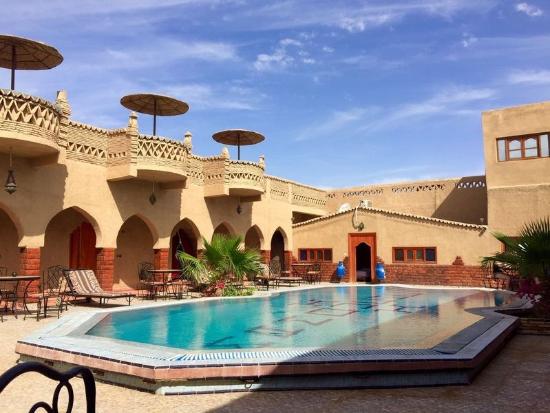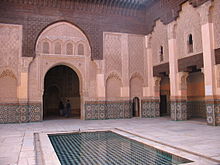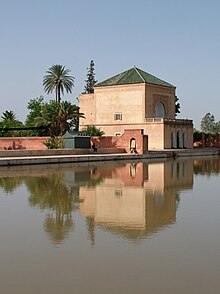Marrakech is the third largest city in Morocco after Casablanca and Rabat, and lies near the foothills of the snow capped Atlas Mountains and a few hours away from the foot of the Sahara Desert. Its location and contrasting landscape has made it an enviable destination in Morocco.
The city is divided into two distinct parts: the Medina, the historical city, and the new European modern district called Gueliz or Ville Nouvelle. The Medina is full of intertwining narrow passageways and local shops full of character; it also contains the large square Jeema el fna, where many hotels are located and tourists, locals and vendors congregate. In contrast, Gueliz plays host to modern restaurants, fast food chains and big brand stores.
Marrakech is the main tourist destination in Morocco and thus, unfortunately, also a place where many Moroccans try to become rich fast by ripping off tourists. This mentality is so widespread that even Moroccans are now ripped off whenever possible so that they call the city "Marrakech, Arnakech" - which rhymes in Arabic and translates to "Marrakech, Mafia". See the Scam section for more information.
Once in the medina, everything can be seen on foot, though you'll be doing a lot of walking. Many tourist destinations are signposted by brown, red or green signs affixed to posts or to buildings. Bear in mind that many of these signs don't take the direct route, and some seem to deliberately send tourists via various markets or other places money may be spent.
For
exploring more of the city, buses and petits taxis are plentiful.
There is much to see and do in Marrakech. An entire day can be dedicated to wandering around all the different souks, seeking out the best bargains. The city also offers several historical and architectural sites as well as some interesting museums.
- 1 Djemaa El-Fna. The highlight of any Marrakech night. Musicians, dancers, and story tellers pack this square at the heart of the medina, filling it with a cacophony of drum beats and excited shouts. Scores of stalls sell a wide array of Moroccan fare (see the Eat section) and you will almost certainly be accosted by women wanting to give you a henna tattoo. Enjoy the various shows, but be prepared to give some dirhams to watch. By day it is largely filled with snake charmers and people with monkeys, as well as some of the more common stalls.
- 2 Maison de la Photographie, 46, Rue souk Ahal Fès (200 m behind Ben Youssef Medersa - Koranic School). A little photography museum, it has one of the highest roof terraces in the Medina. MAD 40.
- 3 The Souks (suuqs). Markets of Marrakech, just adjacent to Place Djemaa El-Fna, are where you can buy almost anything. From spices to shoes, jellabas to kaftans, tea pots to tagines and much, much more. Undoubtedly, being a foreigner means you will end up paying higher prices than a native would, but be sure to bargain nonetheless. If you happen to run out of dirhams, you will also find plenty of people in the souks who will eagerly exchange your dollars or euros (though a fair rate here is less likely than at an official exchange). All that said, the sellers here are much less aggressive than say, Egypt or Turkey, so have fun!
- 4 Koutoubia Mosque (right besides Djemaa El-Fna). Named after the booksellers market that used to be located here. It is said that the minaret of the Koutoubia mosque is to Marrakech as the Eiffel Tower is to Paris. The minaret is visible from Gueliz which is connected to the Medina by Avenue Mohammed V. At night, the mosque is beautifully lit. Non-Muslims are not allowed inside.
- 5 Tanneries. Visiting the Tanneries can be an interesting experience. Even if some people tell you the area is only for locals, it is possible to visit the Tanneries without paying a youngster. After finding a Tannery, ask one of the workers if you can visit it and take pictures
- 6 Saadian Tombs. The tombs were not discovered until the beginning of the 20th century. They have been preserved just like they were during the glory days of the Saadian rulers. Unlike the El Badi Palace, they were not destroyed, probably for superstitious reasons. The entrance was blocked so they remained untouched for hundreds of years. Inside you will find an overload of Zelij (Morrocan tiles) and some beautiful decoration. It does not take a lot of time to explore, but it is definitely worth the visit. While here, look for the tombs of Jews and Christians; they are noted by their different markings and direction of the tomb. MAD 10.
- 7 Majorelle Gardens (Jardin Majorelle), Rue Yves Saint Laurent, 40090 Marrakech (In Gueliz), daily, Oct-Apr: 8-17:30, Mai-Sep 8-18, Ramadan: 9-17. It provides an excellent respite from the hustle and bustle of the city streets, if not crowded by tourists as it sometimes is. The park was designed by the artist Jacques Majorelle in the 1920s and 1930s. Since 1980 the garden has been owned by Yves Saint-Laurent and Pierre Bergé. It boasts a collection of plants from across the globe, including what seems like every cactus species on the planet. Get here early to avoid the crowds. Inside the gardens is also the Berber Museum, which shows a slightly bigger and more modern presentation than the Dar Si Saïd. 70 MAD, 30 MAD extra for the Berber Museum.)
- 8 Dar Si Saïd Museum (on Rue Riad Zitoun Jdid, is a museum 5 mins away from Djemaa El-Fna.). 9:00–16:30. Museum set in an old palace with beautiful gardens. While somewhat run-down, it is worth seeing and houses many different artifacts from Morocco through the ages, such as wood carvings, musical instruments, and weapons. It is dedicated to the Moroccan craft industry of wood, gathering a very beautiful collection of popular art: carpets, clothing, pottery and ceramics. All these objects are regional, coming from Marrakech and all the south, especially from Tensift, High Atlas, Soussthe, Anti Atlas, Bani, and Tafilal. MAD 10, children below 12 MAD 3.
- 9 Ben Youssef Madrasa, Kaat Benahid (in the old Medina). 9:00-18:00, closed for religious holidays.. One of the largest Madrassas in the North Africa. It is a school attached to the Ben Youssef Mosque and is home to beautiful art and architecture. Build ca 1570. Dh 40, Dh 60 combined with the Museum of Marrakech.
- 10 El Bahia Palace, . Daily 08:00–17:00. An ornate and beautiful palace, build at the end of the 19. century for grand viziers of the sultan. Popular with guided tours and stray cats. The palace is well worth a visit and gives a great impression of what it must have been like to be a 19th century nobleman in Morocco. There is a nice garden with banana flowers, tranquil courtyards, and other lovely plants. MAD 10, children below 12 MAD 3.
- 11 El Badi Palace, Ksibat Nhass. 08.30-11.45, 14.45-17.45. A palace now in ruins and inhabited by storks and stray cats. There are some underground passageways to explore. The view from the terrace is majestic. The palace was built by Sultan Ahmed al Mansour to celebrate the victory of the Portuguese army in 1578 in the Battle of the three kings.
This minbar dates back to the 12th century and on display in a single room with some explanations<. A minbar is a preaching chair.
Also hosts the Marrakech Museum for Photography and Visual Arts (abbreviated MMP+), a small museum which however showcases great pieces of visual art. Entrance fee for this museum is included in the Palace entrance fee, it is open from 9AM to 5PM. MAD 10 admission to the palace, MAD 10 extra to see the old Kotoubia Mosque minbar.
- 12 The Menara gardens (west of the city in walking distance). 5:30-20:00 in the winter. A mixture of orchards and olive groves surrounding the water reservoir with the central pavilion which is a popular sight on tourist postcards. Not a decorative garden, and now quite run down. The pavilion was built during the 16th century Saadi dynasty, and renovated in 1869. It has a small cafe, but it is not open all hours. There are no toilets open when the cafe is closed. fee
- 13 Jewish Cemetery, Avenue Taoulat El Miara, Marrakech (adjacent to the mellah, within the medina). The largest Jewish cemetery in Morocco, characterized by white-washed tombs and sandy graves.
- 14 Marrakech Museum, 09:00-18:30. MAD 40, MAD 50 including the Ben Youssef Madrasa.
- 15 Musée de la Palmeraie, Dar Tounsi, Route de Fès ("Located in the south of the Palmeraie, it is quite off the main tourist paths, expect to travel at about an hour per direction. You need to get a taxi or hop on bus 17 towards Palmeraie (which does not run often). The route with the museum is off to the left side of the road, the crossroads just before the Atacadao supermarket. You have to head follow the road for about 500m, there are also signs.), 9:00-18:00?. In old agricultural buildings in the Palmeraie, made out of rammed earth. The architecture itself is interesting if you haven't seen it. It offers a small collection of contemporary art, with a room dedicated to Morrocan artists (also famous ones), the international ones are rather not top-notch. The gardens are nicely made and are good place to relax in quit. MAD 40.
- 16 Musee Farid Belkahia, Dar Tounsi, Route de Fès (As to writers knowledge, the museum is located at the seat of the Fondation Farid Belkahia, which is off Route de Fès, Dar Tounsi, walking past Musée de la Palmeraie for further 500m-1km), . closed on Sun, no more info. A museum dedicated to the renowned contemporary artist Farid Belkahia, showcasing different periods of his work
- 17 Tiskiwin Museum, Derb El Bahia 8 (Between El Bahia and Museum Dar Si Said). 9:00-12:30;14:30-18:00. About the people in the Sahara. Created by Dutchman Bert Flint. Dh 20.














Aucun commentaire:
Enregistrer un commentaire